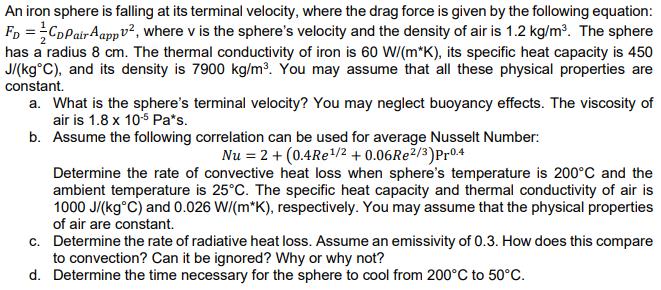Answered step by step
Verified Expert Solution
Question
1 Approved Answer
An iron sphere is falling at its terminal velocity, where the drag force is given by the following equation: FD=CD Pair Aappv, where v

An iron sphere is falling at its terminal velocity, where the drag force is given by the following equation: FD=CD Pair Aappv, where v is the sphere's velocity and the density of air is 1.2 kg/m. The sphere has a radius 8 cm. The thermal conductivity of iron is 60 W/(m*K), its specific heat capacity is 450 J/(kgC), and its density is 7900 kg/m. You may assume that all these physical properties are constant. a. What is the sphere's terminal velocity? You may neglect buoyancy effects. The viscosity of air is 1.8 x 10-5 Pa*s. b. Assume the following correlation can be used for average Nusselt Number: Nu = 2 + (0.4Re /2 + 0.06Re/3) Pr0.4 Determine the rate of convective heat loss when sphere's temperature is 200C and the ambient temperature is 25C. The specific heat capacity and thermal conductivity of air is 1000 J/(kgC) and 0.026 W/(m*K), respectively. You may assume that the physical properties of air are constant. c. Determine the rate of radiative heat loss. Assume an emissivity of 0.3. How does this compare to convection? Can it be ignored? Why or why not? d. Determine the time necessary for the sphere to cool from 200C to 50C.
Step by Step Solution
There are 3 Steps involved in it
Step: 1

Get Instant Access to Expert-Tailored Solutions
See step-by-step solutions with expert insights and AI powered tools for academic success
Step: 2

Step: 3

Ace Your Homework with AI
Get the answers you need in no time with our AI-driven, step-by-step assistance
Get Started


